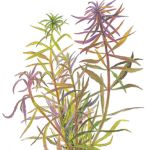| Common Name: |
Rau om |
| Other Names: |
Berema, Ngô om, Rau ngô, Rice paddy herb, swamp leaf |
| Botanical Name: |
Limnophila chinensis subsp. aromatica syn. L. aromatica |
| Genus: |
Limnophila |
| Family: |
Scrophulariaceae |
| Native Location: |
S Asia, Australia |
| Cultivation: |
Damp to wet soil, or shallow water, in sun or partial shade. |
| Propagation: |
By seed sown when ripe; by stem tip cuttings or division during the growing season. |
| Harvest: |
Sprigs of foliage are cut as required and used fresh for flavoring, poultices, and decoctions. |
| Height: |
30cm (12in) |
| Width: |
Indefinite |
| Hardiness: |
Min. 20°C (68°F) |
| Parts Used: |
Leaves, stem tips. |
| Properties: |
An aromatic herb with laxative, expectorant, and healing effects. |
| Medicinal Uses: |
Internally, in Sri Lanka, for fevers, and externally as a poultice for sores. |
| Culinary Uses: |
Leafy stems are used to flavor soups, stews, curries, and sweet-and-sour dishes, especially in Vietnamese cuisine. |
| Bibliography: |
Encyclopedia of herbs by Deni Brown Copyright © 1995, 2001 Dorling Kindersley Limited. pg 262 |

